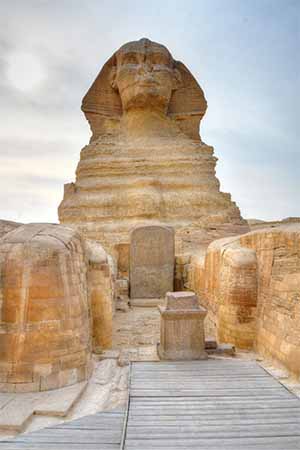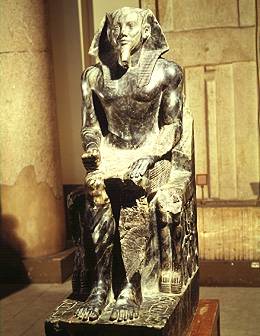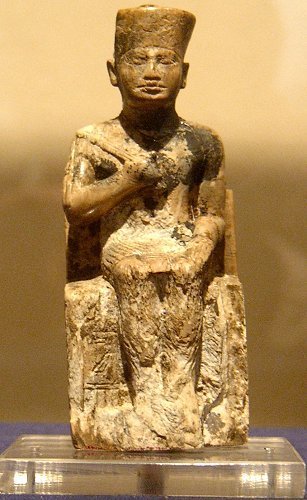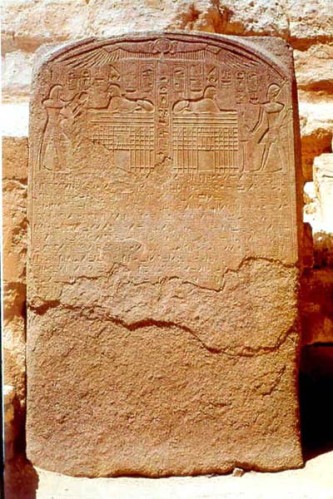Great Sphinx of Giza Secrets
Was It Built by Egyptians ?

Sphinx secrets
Not far from Cairo, on the Giza Plateau, lies one of the most emblematic and mysterious constructions of Ancient Egypt: the Great Sphinx or Horus in the Horizon according to its royal epithets. Hybrid creature sporting a lion's body and a man's head, the Sphinx of Giza would've been erected to watch over the greatest and oldest secrets of Egyptians. Under the gigantic pit where the Sphinx is solidly anchored would lie mysterious hidden crypts whose vocations are unknown. Some speak of a tomb sheltering enigmatic King Horemheb's mummy, the history of whom was erased from the annals of the empire. According to Edgar Cayce, a famous clairvoyant, the Sphinx of Giza was built over a room where very old manuscripts are preserved ; probably those of the mythical Atlantis or the legendary Books of Thoth.
Why was the Sphinx built ?
The vocation of the Sphinx is as mysterious as its dating which until now continues to baffle the most competent archaeologists. If we could somehow prove that the Great Sphinx is actually older than 10,000 years, then the question that would arise is who are its builders ? Moreover, although the impenetrable gaze of the Sphinx of Giza has long been associated with that of Pharaoh Khafra', it seems today that these assumptions are groundless. Above all, the image of the Sphinx represents the divine wisdom and the power of pharaonic Egypt.
When was the Sphinx built ?

Traditionally, Egyptian history specialists have dated the construction of the Sphinx of the 4th Dynasty of the Old Kingdom and more precisely of the time of Khafra, around 2500 BC. The only problem is that the dating is not based on any scientific data but on the simple finds of some statues discovered not far from the Great Sphinx of Giza by Egyptologist Auguste Mariette in 1853 and which undoubtedly belonged to Khafra.
Sphinx discovery
For more than 3,000 years, from Antiquity all the way down to the nineteenth century, the eroded body of the Sphinx remained buried under tens of thousands of tons of sands; only its enormous head, gazing towards the Nile River, was still visible at the time of its rediscovery in 1817 by adventurous Giovanni Caviglia. Dredging reveal an impressive Roman sanctuary and a stele erected by the 18th Dynasty (the Dream Stele of Thutmose IV) located directly between the legs of the Great Sphinx. The famous statue was then rediscovered again in 1828 by a French Egyptologist and in 1853 by Auguste Mariette hoping to pierce once and for all the mystery and secrets of the Great Sphinx of Giza.

How old is the Sphinx ?
In 1990, wishing to solve the mystery surrounding the year of the Sphinx' construction, a team of researchers including prominent geologists and geophysicists took many rock samples and noted that relatively to other nearby Old Kingdom monuments, the Great Sphinx shows advanced spoilage which cannot be attributed to the simple action of sands and wind. Clearly, the Sphinx has been exposed to severe storms or even floods over a prolonged period. But the thing is, the Sahara is an extremely arid region and the last real floods date back to a time when the soil was still dotted with greenery, about 10,000 years ago. The Great Sphinx would thus precede pyramids by several thousand years according to this hypothesis. If this were the case, a civilization prior to Egyptians would've built it.
The Sphinx in the image of Khafra ?

Rumors circulated that the Sphinx was carved in the image of Pharaoh Khafra which would strongly support the thesis that it was built by the 4th Dynasty of the Old Kingdom. American jurists specializing in the field of facial characteristics studies, however, denied this hypothesis asserting that the Sphinx' features do not correspond to those of Khafra.
The business of Khufu
According to Mark Lehner, a great connoisseur and bearer of a doctoral thesis on the Great Sphinx of Giza, it is absolutely impossible to date the statue since it is carved out in natural rock. He believes, however, as many others that the Sphinx is the work of a Fourth Dynasty Pharaoh. For Rainer Stadelmann, the Sphinx, like the Great Pyramid of Giza, is the business of Khufu. His argument is mainly founded on the alignment of the two construction axes, which are perfectly enligned, and on the analysis of the two pharaoh's character; the lion would associate better with Khufu who undertook very large projects.

No mention in historical archives
Surprisingly, of all great Antiquity historians such as Herodotus and Diodorus Siculus or geologist Strabo, none of them mention the Sphinx in their writings; it is as if it never existed or was totally buried. Old Kingdom manuscripts are also silent on the subject. The only ancient description of the Sphinx comes from Pliny the Elder who slipped a few words including an allusion to silence. What could possibly be hidden behind the Great Sphinx of Giza and why are so many people quiet about it ?
The Dream Stele

The Dream Stele, which adorns the Sphinx' legs, was erected by Thutmose IV of the 18th Dynasty. Engraved in pink granite, one can see Pharaoh Thutmose IV giving offerings to the Sphinx which he refers to as Horus in the Horizon. If one believes the myth and the name given to the Stele, Thutmose would have been given the mission of dredging and restoring the Sphinx in a dream. The Dream Stele also shows two Sphinxes gazing in opposite directions, leading some to believe that somewhere on the Giza Plateau hides a second Sphinx, probably buried under a mountain of sand, somewhere.









































































































































































































































































































































